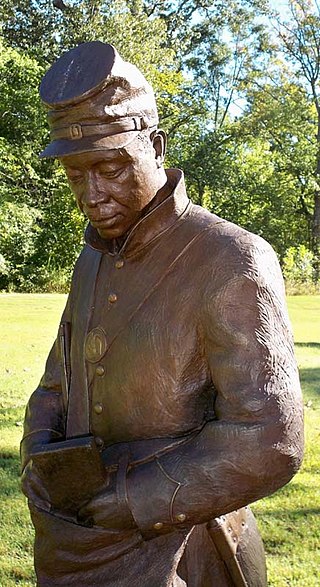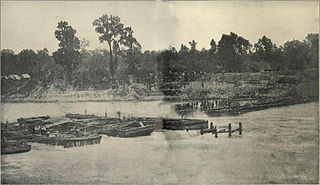
United States Colored Troops (USCT) were Union Army regiments during the American Civil War that primarily comprised African Americans, with soldiers from other ethnic groups also serving in USCT units. Established in response to a demand for more units from Union Army commanders, USCT regiments, which numbered 175 in total by the end of the war in 1865, constituted about one-tenth of the manpower of the army, according to historian Kelly Mezurek, author of For Their Own Cause: The 27th United States Colored Troops. "They served in infantry, artillery, and cavalry." Approximately 20 percent of USCT soldiers were killed in action or died of disease and other causes, a rate about 35 percent higher than that of white Union troops. Numerous USCT soldiers fought with distinction, with 16 receiving the Medal of Honor. The USCT regiments were precursors to the Buffalo Soldier units which fought in the American Indian Wars.

Franklin Kitchell Gardner was a Confederate major general in the American Civil War, noted for his service at the Siege of Port Hudson on the Mississippi River. Gardner built extensive fortifications at this important garrison, 16,000 strong at its peak. At the mercy of conflicting orders, he found himself besieged and greatly outnumbered. His achievement at holding out for 47 days and inflicting severe losses on the enemy before surrendering has been praised by military historians.

Cyrus Hamlin was an attorney, politician, and a general from Bangor, Maine, who served in the Union Army during the American Civil War.
The 8th Louisiana Regiment Infantry (African Descent) was an infantry regiment in the Union Army during the American Civil War. It was composed primarily of freed or escaped slaves from Louisiana's plantations and was commanded by white officers.
The 3rd Louisiana Regiment Native Guard Infantry was a regiment in the Union Army during the American Civil War.
The 2nd Louisiana Regiment Native Guard Infantry was a regiment in the Union Army during the American Civil War. It was organized in New Orleans and was tasked with defending the city until being redeployed to Ship Island in Mississippi. Its higher-ranking officers were white and lower grade officers and enlisted men were mixed heritage and African American.
The 41st Regiment Massachusetts Volunteer Infantry was a three-year infantry regiment that served in the Union Army during the American Civil War. It was recruited as part of Governors Banks' and Andrew's recruitment drives to supply the union with a military force to hold and expand Union control of the lower Mississippi. In the late winter/early spring of 1863, it was converted to mounted infantry and later to cavalry. On its conversion in June 1863 at Port Hudson, it was disestablished and re-established as the 3rd Massachusetts Volunteer Cavalry.

The 1st Louisiana Native Guard was the first all-black regiment in the Union Army. Based in New Orleans, Louisiana, it played a prominent role in the Siege of Port Hudson. Its members included a minority of free men of color from New Orleans; most were African-American former slaves who had escaped to join the Union cause and gain freedom. A Confederate regiment by the same name served in the Louisiana militia made up entirely of free men of color.

The 2nd Missouri Colored Infantry Regiment was an African-American infantry regiment that served in the Union Army during the American Civil War. Redesignated as the 65th U.S. Colored Troops Regiment on March 11, 1864.

The 3rd Missouri Colored Infantry Regiment was an African-American infantry regiment that served in the Union Army during the American Civil War. It was redesignated as the 67th U.S. Colored Troops Regiment on March 11, 1864.

The 55th United States Colored Infantry Regiment was a United States Colored Troops infantry regiment in the Union Army during the American Civil War. It was first organized as the 1st Alabama Volunteer Infantry Regiment (African Descent) in May 1863, serving on garrison duty at Corinth, Mississippi and Memphis, Tennessee. It was redesignated as the 55th United States Colored Infantry in March 1864, continuing its garrison service in Tennessee and fighting at the Battle of Brices Cross Roads. After the end of the war, the regiment was mustered out in late 1865 after garrison duty in Louisiana.

The Corps d'Afrique was an African American corps that served in the Union Army during the American Civil War.
The 52nd United States Colored Infantry was an infantry regiment composed of African-American troops recruited from Mississippi that served in the Union Army during the American Civil War. On July 4, 1864, the 52nd Colored Infantry fought a battle at Coleman's Plantation in Jefferson County, Mississippi. This engagement is notable as it is most likely the first time that Black soldiers from Mississippi fought against white Confederates from the same state.
The 53rd United States Colored Infantry was an infantry regiment that served in the Union Army during the American Civil War. Originally formed as the 3rd Regiment Mississippi Volunteers (African Descent), the regiment was composed of African American enlisted men commanded by white officers. The 53rd served on garrison duty in Louisiana, Mississippi, and Arkansas before being mustered out of service in 1866.

Henry Demas was an enslaved African American who became a constable, state legislator, civil rights activist, and organizer of Southern University in Louisiana during the Reconstruction era.

The 97th United States Colored Infantry was an engineer regiment designated as infantry as part of the United States Colored Troops that served in the Union Army during the American Civil War and fought in the Western Theater of the American Civil War in the Department of the Gulf. The regiment mustered in at Camp Parapet April 28, 1863, as the 1st Louisiana Engineers, but two companies, D and F had been hastily mustered into service two days earlier, April 26, 1863, and sent to Berwick City to remove obstructions from the Bayou Teche. The enlisted men of the 1st Louisiana Engineers were formerly enslaved men in the “engineer camp” who had been previously providing labor for the U.S. Army between New Orleans and Baton Rouge. Several of the newly commissioned company grade officers had been enlisted men of the 42nd Massachusetts Volunteer Infantry who had been on engineer service superintending the contraband laborers from the camp. In the summer of 1862, General Phelps had previously requested to arm the men at Camp Parapet and put them in uniform to defend the city of New Orleans but his request was denied. Gen. Banks ordered Phelps to have the men cut down all the trees between Camp Parapet and Lake Pontchartrain. Phelps resigned over the issue stating, "...while I am willing to prepare African regiments for the defense of the government," he continued, that he " was not willing to become a mere slave driver."

81st Regiment Infantry U.S. Colored Troops was a regiment of United States Colored Troops during the American Civil War. Initially formed as the 9th Infantry, Corps d'Afrique on September 2, 1863, the regiment was re-designated as the 81st Regiment Infantry on April 4, 1864. It primarily served at Port Hudson, Louisiana, and was mustered out on November 30, 1866.

The 4th United States Colored Cavalry Regiment was an African American cavalry regiment that served in the Union Army during the American Civil War. The regiment mustered in as the 1st Cavalry (Corps d'Afrique) at New Orleans on September 12, 1863 and was stationed for the entirety of its existence at various bases throughout Louisiana, mustering out at New Orleans on March 20, 1866.
The 66th United States Colored Infantry Regiment was an infantry regiment composed of African-American troops recruited from Mississippi that served in the Union Army during the American Civil War. The 66th Regiment was posted on garrison duty in Mississippi, Louisiana, and Arkansas, and fought several skirmishes with Confederate troops around the Mississippi River before being mustered out of service in 1866.
The 4th Louisiana Native Guard Infantry Regiment was an African-American unit of the Union Army during the American Civil War. The 4th Native Guard was later redesignated as the 4th Regiment, Corps d' Afrique, and then finally as the 76th US Colored Infantry Regiment. The Regiment took part in battles at Port Hudson, Louisiana, and Fort Blakely, Alabama before being mustered out of service in December, 1865.










